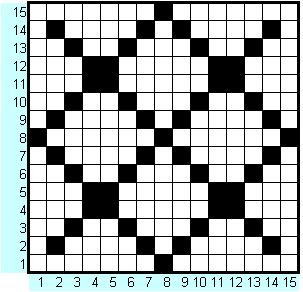In designing a filet crochet pattern, the first thing to remember is that each "square" is actually 3 sts wide – a dc plus either 2 dc's or 2 ch's. The height of each "square" is a dc's height or, in other words, the height of 2 ch's.

I used a spreadsheet for this. In order to make a filet crochet pattern that will look a bit like the finished object, one needs to adjust the cell height and width. To do this, select the entire sheet by either clicking in the corner above the "1" and just before the "A" or click "Edit" – "Select all". Then select "Format" – "Row" – "Row height" and change it to "0.2". Finally, select "Format" – "Column" – "Column height" and change it to "0.3" -- or any combination that will give a ratio of 3 to 2.
After fiddling around a little, here's the design I came up with. (I copied the cells to "Paint" and then saved the result as a .jpg before posting it here.) The black cells are the holes or "open mesh" and the clear ones are the solid part or "closed mesh".

There are 9 cells across. -- which means 9 * 3 + 1 sts across – or 28 sts across on each row. To be different, I decided not to work an edging. So, I'm starting each row with a ch 2 – which is
not a substitute for a stitch. It is there only to make a nicer edge. -- This is an alternative to starting a dc row with ch3 as a substitute for the first dc. -- For this alternative, the first dc of the new row is placed in the top of the last dc of the previous row.
Hint: When making long foundations chains, make the chain longer than needed. Then undo the unneeded sts after finishing the next row. It's better to have too many ch sts at the beginning of a long project than too few.Filet Crochet Diamond DishclothI used some left-over Peaches & Creme (or else Sugar 'n Cream) cotton yarn – worsted weight – and a size 5 or F (3.75 mm) crochet hook.
finished size 7" x 6"
ch 30. Start work in 2nd chain from hook.
Row 1: dc 28, turn
Row 2: ch 2, dc 7, sk 2, ch 2, dc 10, sk 2, ch 2, dc 7, turn
Row 3: ch 2, dc 4, * sk 2, ch 2, dc 4 * across, turn
Row 4: ch 2, dc 13, sk 2, ch 2, dc 13, turn
OR (Row 4: ch 2, dc 1, sk 2, ch 2, dc 10, sk 2, ch 2, dc 10, sk 2, ch 2, dc 1, turn)Row 5: same as Row 3

Row 6: same as Row 2
Row 7: same as Row 3
Row 8: same as Row 4
Row 9: same as Row 3
Row 10: same as Row 2
Row 11: same as Row 1
Fasten off and weave in ends.
Note: When dc-ing a stitch into a chain st, dc into the chain itself just as you did in Row 1.Note: It will look as if you're making the last dc of a row between a dc and the ch 2. This is how it should look.A thought: Filet crochet with dc's and ch-2 holes produces holes that are basically square but a design that is squatted down. The beginning and end rows of dc's were added to counteract this squatness. However, this design could be reworked with triple crochet sts intead of double crochet sts to produce a square dishcloth but holes that are elongated:
ch 31. Start work in 3rd chain from hook.
Row 1: ch 3, tr 7, sk 2, ch 2, tr 10, sk 2, ch 2, tr 7, turn
Row 2: ch 3, tr 4, * sk 2, ch 2, tr 4 * across, turn
Row 3: ch 3, tr 13, sk 2, ch 2, tr 13, turn
OR (Row 3: ch 3, tr 1, sk 2, ch 2, tr 10, sk 2, ch 2, tr 10, sk 2, ch 2, tr 1, turn)Row 4: same as Row 2
Row 5: same as Row 3
Row 6: same as Row 2
Row 7: same as Row 3
Row 8: same as Row 2
Row 9: same as Row 1
Fasten off and weave in ends.
 Between the sections on "Fancy Stitches" and on "Irish Crochet" in the booklet from the American Thread Company (which I inherited from my MIL), there is a section on trims. The first 2 trims it talks about are cords.
Between the sections on "Fancy Stitches" and on "Irish Crochet" in the booklet from the American Thread Company (which I inherited from my MIL), there is a section on trims. The first 2 trims it talks about are cords. The other cord (1. Crocheted Cord) described in the booklet involves crocheting. (Directions for both cords are at the right.) It reminds me of a knitted i-cord.
The other cord (1. Crocheted Cord) described in the booklet involves crocheting. (Directions for both cords are at the right.) It reminds me of a knitted i-cord. "Without joining rows" means do not slip stitch the last stitch of a round to the first stitch of the round -- in other words, work in a spiral just as you did the hotpad.
"Without joining rows" means do not slip stitch the last stitch of a round to the first stitch of the round -- in other words, work in a spiral just as you did the hotpad.







